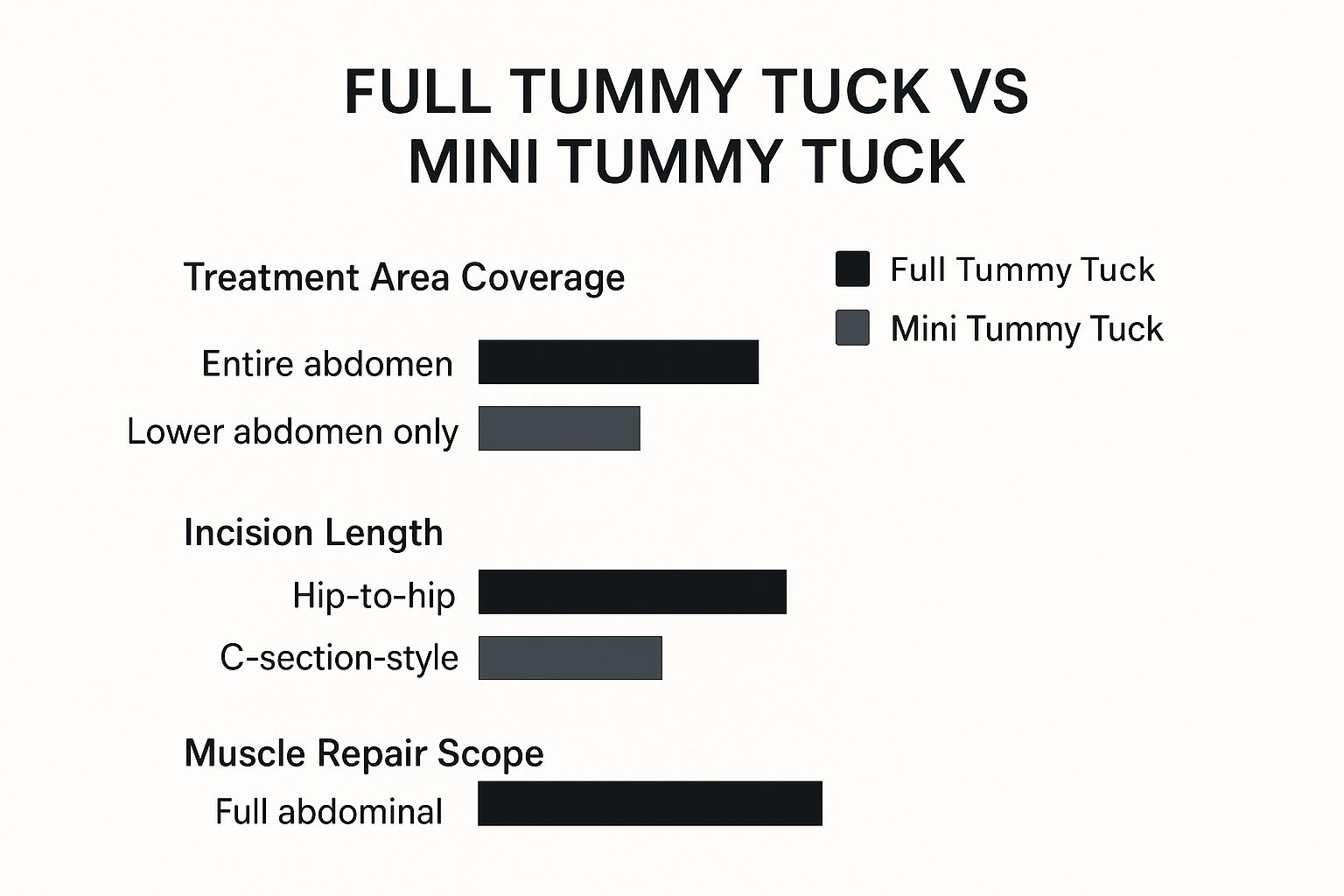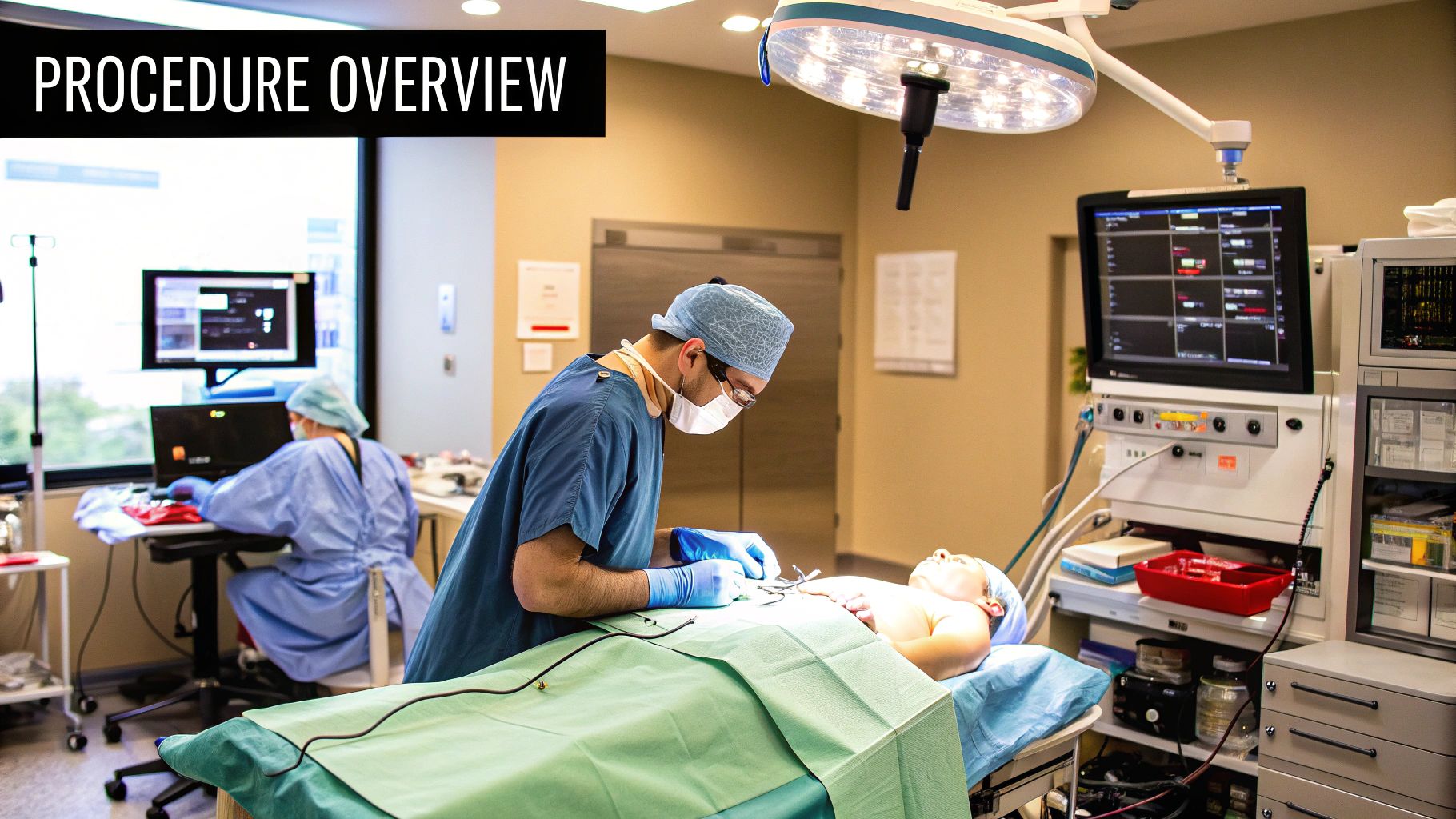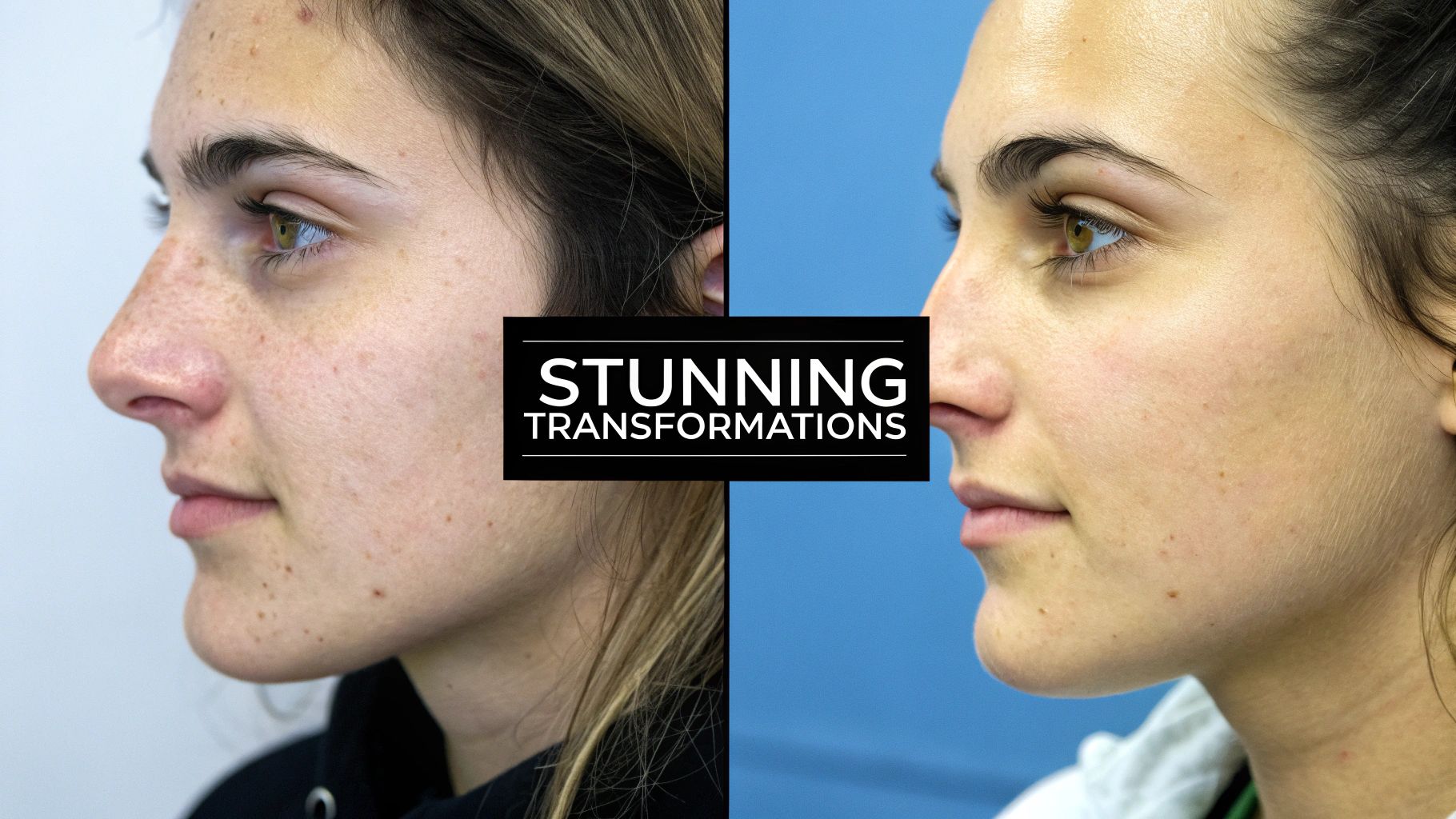
October 20, 2025
Tummy Tuck vs Mini Tummy Tuck Which Is Right for You
Deciding on a tummy tuck vs mini tummy tuck? This guide compares procedures, candidates, recovery, and costs to help you make an informed choice.
Oct 20, 2025

The fundamental difference between a full tummy tuck and a mini tummy tuck comes down to one simple thing: scope. A full tummy tuck is a comprehensive solution that tightens skin and repairs separated muscles across the entire abdomen. On the other hand, a mini tummy tuck focuses exclusively on the small area of skin and fat below the belly button.
Ultimately, your unique anatomy will dictate which procedure is right for you—it's not about personal preference but about matching the surgery to your specific needs to achieve that flat, toned stomach.
When choosing between these two body contouring procedures, the decision really boils down to where your problem areas are. The full tummy tuck, medically known as an abdominoplasty, is the go-to for people with loose skin, stubborn fat, and muscle separation (a condition called rectus diastasis) both above and below the navel. This is a very common situation for women after pregnancy or for anyone who has experienced significant weight fluctuations.
A mini tummy tuck, in contrast, is a much more focused surgery. It’s an ideal fit for a select group of people who are otherwise in great shape but just can't get rid of that persistent "pooch" of skin and fat limited to their lower belly.
The choice between a full and mini tummy tuck is almost entirely based on your body's specific needs. A full tummy tuck is designed to correct widespread laxity and muscle weakness from the rib cage down to the pubic area. The mini version, however, is reserved for those whose issues are strictly confined to the lower abdomen.
In my experience, and as clinical data supports, only a small fraction of patients—about 10–20% of all abdominoplasty candidates—are truly a good fit for a mini tuck. You can find more expert insights on patient selection to see why this is the case.
The infographic below does a great job of showing the primary differences in where we work, how long the incision is, and the extent of muscle repair involved in each procedure.

As you can see, the full tummy tuck delivers a much more dramatic and extensive correction, whereas the mini tummy tuck offers a subtle improvement with a significantly smaller scar.
To quickly break down the most important distinctions, here’s a simple table that summarizes the core differences between a full and mini tummy tuck.
This side-by-side view helps clarify which procedure aligns with different aesthetic goals and anatomical starting points.

When you're weighing a full tummy tuck against a mini, it's crucial to understand that these aren't just slightly different versions of the same surgery. They are two distinct procedures, each designed for very different goals and anatomical issues. Think of a full tummy tuck as a complete reconstruction of the entire abdominal wall, while a mini is more of a targeted refinement for the lower belly.
The demand for these surgeries speaks volumes about how effective they are for common issues like post-pregnancy changes or loose skin after significant weight loss. Back in 2016, surgeons performed nearly 769,000 tummy tucks worldwide, a number that shows just how many people are looking for a real solution for abdominal contouring.
A full abdominoplasty is the more extensive of the two procedures. It all starts with a significant incision that usually runs from hip to hip. A good surgeon will place this low on the abdomen so it's easily hidden by most underwear or a bikini bottom. This long incision is necessary because it gives the surgeon access to the entire abdominal area, from the bottom of the rib cage all the way down.
With the skin lifted, the real work begins. The surgeon repairs the diastasis recti, which is the separation of the abdominal muscles that often happens after pregnancy. By suturing these muscles back together at the midline, we essentially create an internal corset. This is the step that really flattens the stomach and cinches the waist, delivering those dramatic results people want from a full tummy tuck. You can get a deeper understanding of the full abdominoplasty procedure and its comprehensive scope.
Key Differentiator: The defining feature of a full tummy tuck is the complete reconstruction of the abdominal wall. It tightens muscles both above and below the navel, something a mini tummy tuck cannot achieve.
Another key part of a full tuck is creating a new position for the navel. After the skin is pulled down tightly, the surgeon makes a new opening for the belly button to ensure it looks natural and proportional. The belly button itself stays attached to its original stalk underneath, so it settles into its new home looking completely natural.
The mini tummy tuck is a much less invasive operation. The incision here is significantly shorter, often just a bit longer than a C-section scar, and it's placed very low above the pubic hairline. This smaller opening gives the surgeon direct, albeit limited, access to the lower abdomen.
The main goal of a mini tuck is to remove that stubborn "pouch" of excess skin and fat below the belly button. Any muscle tightening is also confined to this lower region and is far less extensive than what's done in a full procedure.
Because all the surgical work happens below the navel, the belly button isn't touched at all—it stays exactly where it is. This is a huge plus for many patients, as it means no scar around the navel, which is unavoidable with a full tummy tuck. If you're looking into less invasive options, it might also be worth comparing this to things like non-surgical fat dissolving injections to see the full spectrum of what's available.

Choosing between a full and mini tummy tuck isn't really a matter of personal preference. It comes down to a clinical assessment of your body's specific needs. The right surgery for you is the one that directly targets the anatomical issues you're facing, whether that's loose skin across the whole stomach or just a small, stubborn pooch.
One thing is non-negotiable for either procedure: you must be at a stable weight. Tummy tucks are about contouring and tightening, not weight loss. If you're still working toward your goal weight, some people find options like prescription weight loss medication helpful under a doctor's guidance before considering surgery.
A full abdominoplasty is designed for people whose concerns span the entire abdomen—from just below the ribs all the way down to the pubic bone. This typically applies to individuals who have experienced major changes to their body.
Here are a couple of classic examples:
In situations like these, a mini tummy tuck just won't cut it. It simply can't address loose skin above the navel or perform the extensive muscle repair needed to create a flat, toned stomach. For these candidates, a full tummy tuck is the only path to a complete transformation.
Honestly, the ideal candidate for a mini tummy tuck is a rare find. This is a highly specialized procedure meant for a very limited and specific problem. The best candidates are already at or extremely close to their ideal weight and have great skin elasticity everywhere else.
Let's paint a picture of the perfect mini-tuck patient:
Key Takeaway: A mini tummy tuck is a spot treatment for the lower abdomen. If you have any loose skin above your belly button or a noticeable bulge from separated muscles, a full tummy tuck is almost always the better, more effective choice.
The bottom line is that only a small fraction of patients are truly suited for a mini procedure. Most people who come in for a consultation have concerns that extend beyond the lower belly, making the full tummy tuck the gold standard for achieving that smooth, firm, and natural-looking result.

The surgery itself is just one part of the equation. What happens afterward—your recovery and final results—is where the real differences between a tummy tuck vs mini tummy tuck become clear. A full tummy tuck is a more involved procedure, which means a longer healing period is part of the package. But for that investment of time, you get a much more dramatic transformation.
On the other hand, a mini tummy tuck is less invasive, getting you back on your feet and into your routine much faster. Its results are more localized and subtle. Your personal goals and lifestyle will play a huge role in deciding which path is the right one for you.
Recovering from a full tummy tuck is a process that can't be rushed. The first 1-2 weeks are all about rest and giving your body the downtime it needs. You’ll be wearing a compression garment around the clock to help control swelling and support your healing abdomen. It’s also common to have temporary surgical drains in place for the first few days to manage fluid.
Most people feel ready to head back to a desk job or other light activities after about two weeks. But when it comes to hitting the gym or doing any heavy lifting, you’ll need to hold off for a full 6-8 weeks. Sticking to your surgeon’s instructions is absolutely critical for a safe recovery. For a more in-depth look, these tummy tuck recovery tips offer some excellent guidance on navigating this period.
A full tummy tuck delivers a comprehensive, top-to-bottom change. It flattens the entire abdomen—from the rib cage down to the pubic bone—and tightens stretched muscles to create a sculpted waistline. The trade-off is a longer scar, which typically runs from hip to hip but is placed low enough to be hidden by a bikini bottom. There will also be a small, discreet scar around your newly positioned belly button.
With a mini tummy tuck, the recovery is significantly shorter and more manageable. Many patients are back to work and light daily routines in about a week. Because the surgery is less extensive, drains often aren't needed, which simplifies the early stages of healing.
You'll still wear a compression garment for support, but discomfort is generally much milder. Most people get the green light to resume all their normal activities, exercise included, within just 3-4 weeks. This quicker turnaround is a major plus for anyone who can’t step away from work or family life for an extended period.
The aesthetic results from a mini tummy tuck are about refinement, not a complete overhaul.
In short, a mini tummy tuck offers a beautiful, subtle improvement for the lower abdomen—an ideal solution for the right person.
https://www.youtube.com/embed/7BELFhmdQxE
When you're weighing a full tummy tuck against a mini, cost is almost always part of the conversation. It's an important one. While it’s true that a mini tummy tuck generally comes with a lower price tag, letting cost be the only deciding factor can be a real misstep.
The smarter approach is to think of this as an investment. You want to choose the procedure that will give you the best possible outcome for your body—one that you’ll be happy with for years to come. Picking the "cheaper" option when it’s not the right fit often leads to disappointment and, in some cases, a second, more expensive surgery to fix things later on. The best value is always in getting it right the first time.
The final price of either surgery isn't just one number; it's a combination of several different costs. You're looking at the surgeon's fee, the fee for the surgical facility (the operating room), and the anesthesiologist's fee.
A full tummy tuck is simply a longer and more complex operation. It requires more time and resources, which is why all of these associated costs are higher. A mini tummy tuck is a shorter, more focused procedure, and that efficiency is reflected in its lower overall cost.
For a clearer picture of how these expenses add up, you can review our detailed cosmetic surgery pricing to see a transparent breakdown.
To give you a clearer idea, here's a general look at how the costs might compare.
Note: These are estimates and can vary significantly based on geographic location, surgeon experience, and the specifics of your procedure.
As you can see, the final investment differs quite a bit, but the most important takeaway is what you get for that cost.
The most expensive surgery is the one you have to do twice. Choosing a procedure based on what your body needs—not just on the initial price—is the smartest long-term financial decision you can make.
Let’s put this into a real-world context. Imagine someone has loose skin both above and below their belly button, plus separated abdominal muscles. If they choose a mini tummy tuck just to save money, only the small area below the navel will be tightened.
The loose skin and bulge in the upper abdomen will still be there. This creates an unbalanced, unnatural look that most people are very unhappy with. That person will likely end up back in a surgeon's office seeking a full tummy tuck to correct the remaining issues, ultimately paying far more than if they had just chosen the right procedure from the start.
True value isn't about the lowest upfront cost. It's about achieving a result that aligns perfectly with your goals and anatomy—ensuring you're satisfied with your investment for the long haul. A one-on-one consultation with a board-certified plastic surgeon is the only way to figure out which procedure will truly pay off for you.
When you're weighing the pros and cons of a tummy tuck vs. a mini tummy tuck, a lot of specific questions pop up. Let's get straight to the answers for some of the things my patients ask most often.
This is a big one. A mini tummy tuck can only tighten muscles below the belly button. So, if you have just a little bit of looseness in that lower area, it might be enough.
But for significant diastasis recti—that classic post-pregnancy ridge that runs down your midline—a mini tuck just won't cut it. To truly fix that kind of separation, a surgeon needs to access and repair the entire length of the abdominal wall. That requires a full tummy tuck.
It's a common misconception, but tummy tucks aren't weight loss procedures. Think of them as body contouring surgeries. Their job is to remove loose, sagging skin and tighten the muscle wall to create a flatter, more toned abdomen.
You will lose a few pounds from the skin and tissue that's removed, but the real transformation is in your shape. For the best, most lasting results, you should be at a stable, healthy weight you're happy with before surgery. This ensures the beautiful new contour we create stays that way.
A Quick Reality Check: These are shaping procedures, not a shortcut to weight loss. Getting to a stable weight before your surgery is the absolute key to a successful outcome you'll love for years.
While articles like this are a great starting point, the only way to know for certain is to sit down with a board-certified plastic surgeon. A hands-on consultation is where the real decision gets made.
During your visit, your surgeon will do a physical exam, checking for three main things:
We’ll talk about what you want to achieve and look at your health history to give you a clear, honest recommendation. A simple "pinch test" can offer a clue: if you can only pinch a small roll of skin below your navel, a mini might be on the table. But if there’s loose skin everywhere, a full tummy tuck is almost always the answer.
The belly button is actually one of the clearest differences between the two procedures, and it completely changes the final look and scarring.
With a full tummy tuck, your surgeon pulls down the skin from your entire abdomen. To make sure your belly button stays put, we make a small incision around it, leaving it attached to the muscle wall underneath. Then, we create a new opening for it in the tightened skin.
In a mini tummy tuck, all the work happens below the navel. Your belly button is never touched. It stays right where it is, meaning there's no scar around it. In some rare cases, it might get pulled down slightly as the lower skin is tightened, but it's never detached or repositioned.
At Cape Cod Plastic Surgery, Dr. Fater and his team are here to help you make a confident, informed decision that feels right for you. Schedule your personalized consultation today to explore your options and map out a plan for achieving the natural-looking results you've been hoping for.

October 20, 2025
Deciding on a tummy tuck vs mini tummy tuck? This guide compares procedures, candidates, recovery, and costs to help you make an informed choice.

October 19, 2025
Discover real rhinoplasty before and after photos, learn what to expect, and see final results. Your guide to natural, beautiful changes.

October 18, 2025
Feeling overwhelmed? This guide simplifies how to choose a surgeon. Get expert tips on credentials, experience, and consultation to make a confident choice.